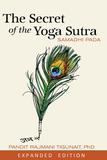Q: In the Yoga Sutra, Patanjali says that practice becomes firm when it is done with respect. Does this mean taking care to do a practice accurately or is something more required?
A: The word Patanjali uses in the sutra you are referring to (sutra 1:14) is satkara, which is loosely translated as “respect.” Sat means “existent; that which has substance; substantial; real; alive.” Kara means “to do; to make happen; to enable.” Thus satkara means “that which makes practice a living practice; that which breathes life into our practice; that which makes our practice worthy of respect.”
Vyasa, the great sage whose commentary on the Yoga Sutra is recognized as the final authority on both the intent and content of this text, has carefully clarified what it means to do a practice with respect. In commenting on sutra 1:14, he tells us that respect is composed of four principles: tapas, discipline; brahmacharya, sensory restraint; vidya, knowledge; and shraddha, faith. Let’s look at them one by one.
Although tapas is often translated as “austerity or penance,” in the yoga tradition it means “heat” or “fire.” Practices that ignite the fire within us are called tapas. The function of fire is to create heat and illumination. Practices that help us become vibrant, radiant, courageous, enthusiastic, and free from inertia are tapas.
Those who are not committed to tapas do not succeed in the practice of yoga.
Another word for tapas is “discipline.” The scriptures say those who are not committed to tapas do not succeed in the practice of yoga. From a practical standpoint, practicing tapas in daily life means adopting a balanced diet, balanced exercise, balanced thinking, balanced sleep, and performing our actions with balanced understanding. Incorporating this form of tapas closes the door on a large range of distractions, leaving us free to do our practice wholeheartedly.
The second component of respect is brahmacharya. In the yoga tradition, brahmacharya means “refraining from sense indulgence.” The senses are powerful tools to explore the world of objects. When they are disciplined, they tell us exactly what is healthy or unhealthy, good or bad, for us. But when they are confused and disoriented, they run after objects indiscriminately. Cravings confuse our senses. Further, running after sensory pleasures aimlessly depletes the vitality of our body and the clarity of our mind. We cannot accomplish anything with a weak body and a tired, disoriented mind. Self-discipline that includes mastery over the senses and allowing the mind to participate in sensory experiences with purpose lies at the heart of brahmacharya.

The third component of respect is vidya, knowledge or right understanding. In this context, vidya means clear knowledge of the nature of the world and worldly objects and the power they exert on us. It also entails understanding something about the vastness of the inner dimension of life and how little we know of that inner world. And finally, vidya involves understanding how urgent it is to create a bridge between our outer and inner worlds, to direct our worldly resources to gaining access to the inner world, and ultimately, to become a citizen of both worlds. This knowledge not only motivates us to invest wholly in our practice, it also gives us a profound appreciation and reverence for the practice itself. Further, this knowledge naturally leads us to cultivate faith, the fourth component of respect.
The clearer our understanding is, the greater our conviction.
The word for “faith” in the yoga tradition is shraddha, which literally means “that which destroys doubt and fear and enables us to retain experiential knowledge.” Faith defines who we are as seekers. It stands by our side when we are challenged by obstacles, both foreseen and unforeseen. Faith and knowledge go together—they are two sides of the same coin. The clearer our understanding is, the greater our conviction. Knowledge and faith help us do our practice lovingly and respectfully. Together they infuse our mind and heart with a sense of gratitude for our good fortune in having the opportunity to do the practice. We find ourselves motivated to invest as much energy in our practice as possible.
In sutra 1:14 Patanjali writes, “Practice becomes firm only when done for a long period of time, with no interruptions, and with respect.” Taken together, the four aspects of respect—discipline, sensory restraint, knowledge, and faith—breathe life into our practice. A vibrant, living practice induces the mind to flow peacefully inward and find the luminous well of consciousness.

